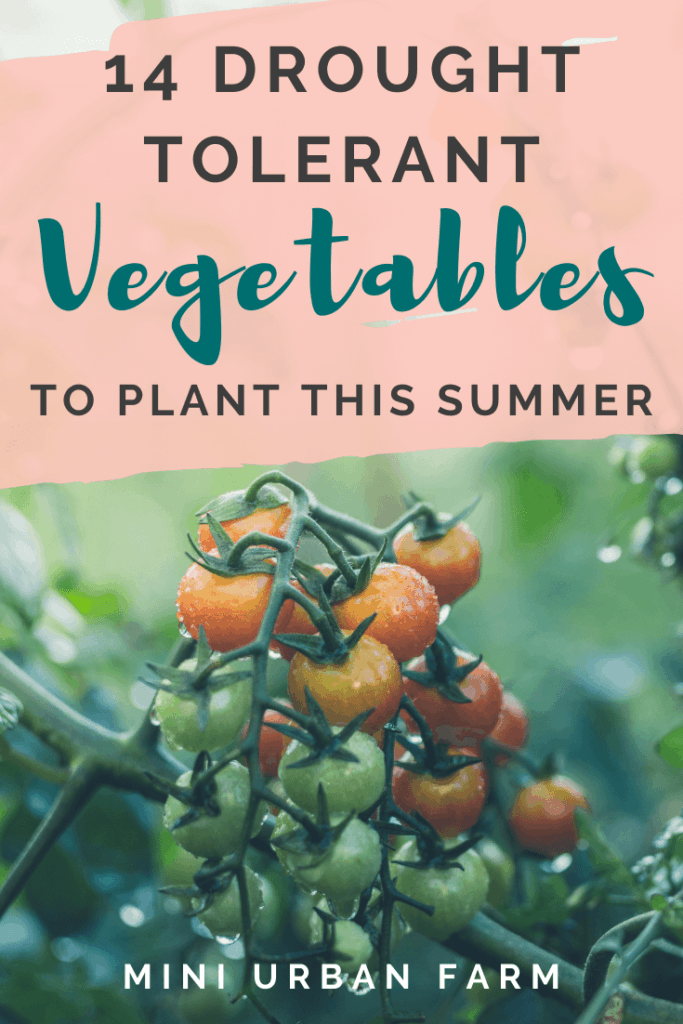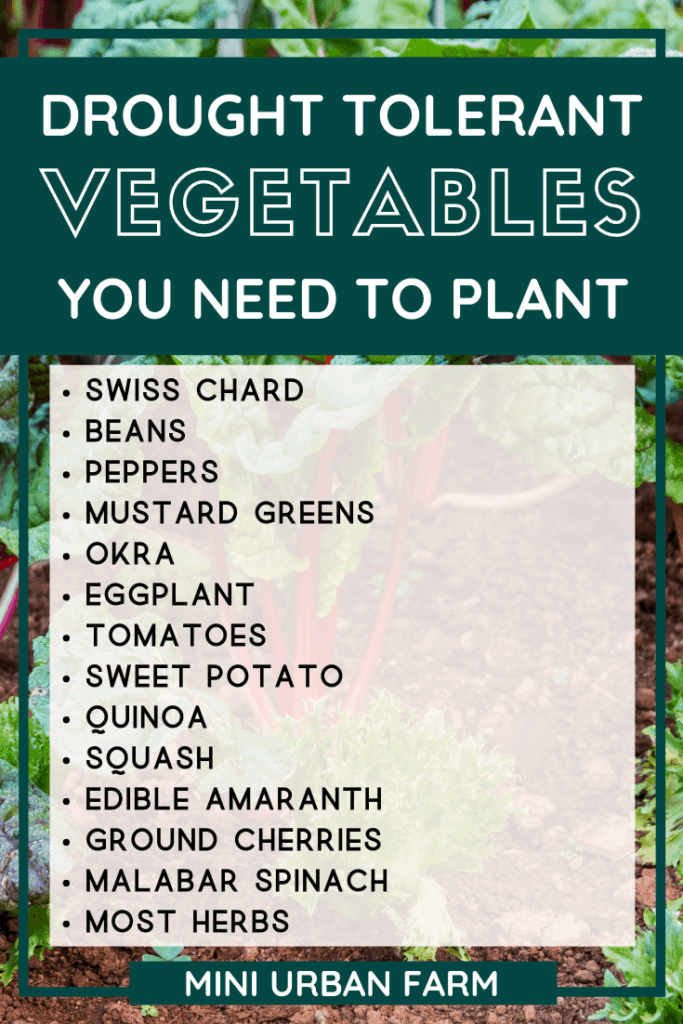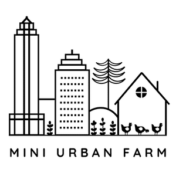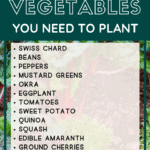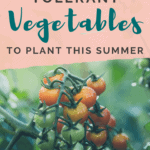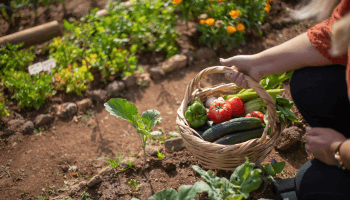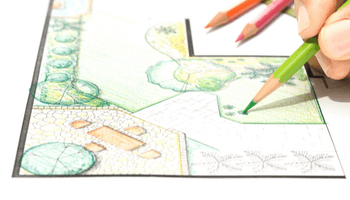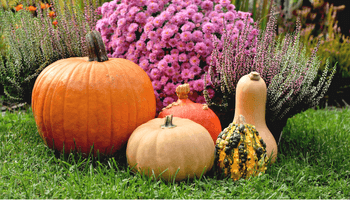If you reside in an area where water is scarce and summers are super hot, then a drought-resistant garden might not be a bad idea! Choosing the right vegetables will ensure that your garden thrives, even with the heat! Plan appropriately by planting drought tolerant vegetables and setting up a good irrigation system!
Drought tolerant vegetables to plant this season:
- Swiss Chard
- Beans
- Peppers
- Mustard greens
- Okra
- Eggplant
- Tomatoes
- Sweet potato
- Quinoa
- Squash
- Edible Amaranth
- Ground cherries
- Malabar spinach
- Most herbs
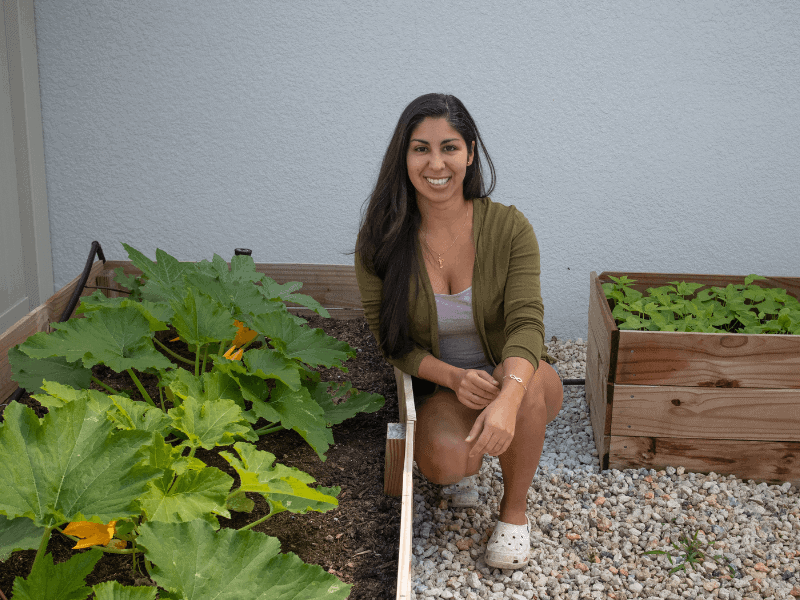
Disclosure: This post may contain affiliate links. If you purchase a product through one of our affiliate links we make a small commission from the sale at no extra cost to our readers.
Drought tolerant vegetable garden
Adding these veggies to your garden will not only get you a great harvest, but they will reduce the amount of time you spend worrying as well!
For example, if I want to take a trip during summer, I can go on vacation without worrying about my garden. And planting these vegetables is one of the best ways to vacation-proof your garden!
1) Swiss Chard
Swiss chard may not be on your list of go-to vegetables, but if you live in a hot climate, it’s the perfect summer crop!
I grow swiss chard year round in Florida, and it takes very little effort (and water) to keep it thriving!
In fact, I rarely have to water my chard and it grows steadily the entire season!
Every so often I notice that it starts to wilt, but then I pour a little water over it and it perks right back up!
So if you tend to neglect your crops sometimes – or if you live in a place with abnormal amounts of heat, then swiss chard is the perfect crop!
You can harvest leaves at any stage for salads, or make a stir fry with the leaves and stems! Just add in some garlic and you have the perfect side dish!
2) Beans
Most varieties of beans, both bush beans and pole beans, are drought tolerant.
I’ve planted beans for years now and they always surprise me on how much they grow and produce with very little effort.
The very first time I planted pole beans I noticed they would grow very fast through any condition – even in the summers over 90 degrees!
And it wasn’t just leafy growth, I always harvest beans 3-5 times per week and have never paid too much attention to them.
This season I’m planting about 5 varieties of beans, because they are so productive, take very little effort, and take up so little space!
Plus at the end of the season they are so easy to freeze and you don’t even have to defrost them to cook them!
If you’re looking for an easy, but super productive crop, beans are one of the best things to plant!
3) Peppers
Peppers love the heat and require relatively less water than other plants. They are an excellent source of vitamin A and C, potassium, fiber and folic acid and are super low in calories!
They also consist of important antioxidants which help build up immunity and aids in reducing the risk of heart diseases!
If that’s not a good enough reason to plant peppers then I don’t know what is!
They are such a staple food in my household – from morning quiche and frittatas to salads and stir fries, peppers are super versatile.
Plus, you can plant both sweet and hot peppers!
I plant sweet peppers for cooking, and jalapenos for drinks! Yes, one of my favorite drinks is a strawberry jalapeño margarita! Don’t knock it ’til you try it!
4) Mustard Greens
I discovered mustard greens a few fall seasons ago when someone gave me an extra packet of red mustard to plant in my garden.
From then on I was hooked!
Mustard greens are a healthy source of vitamin C, A and K. They consist of micronutrients and plant compounds that are good for your eyes, heart, boost your immunity, and also aid in fighting cancer.
They can be grown easily in raised beds, in ground, or even in small containers.
In my raised beds I direct sowed the entire seed packet and didn’t bother to thin them out.
About a month later I was harvesting mustard greens for salads! Now, I don’t know about you, but I love vegetables that grow super quickly.
I always include it in my salads, and I’ve even sauteed it with garlic as a side dish!
Just keep in mind that baby mustard greens are way less spicy than mature greens, so if you’re not into super spicy, then be sure to pick your greens early!
5) Okra
I’ve been eating okra ever since I can remember. My grandmother makes quimbombo when okra is in season which is an okra stew – kinda.
And you can cook okra in so many ways – fried, stewed, stir fry. The possibilities are endless!
Plus, okra is super drought tolerant. It won’t even grow without obscene amounts of heat!
So unfortunately if you live in a very cold climate, you may not be able to grow okra.
I plant out my okra at the end of spring, and it absolutely loves the 95+ degree summer days here in Central Florida.
It’s also really productive and gives a ton of fruit – and freezing it is super easy!
So if you’ve never tried growing it and you live in a hotter climate, try planting okra this season!
6) Eggplant
Eggplant is low on carbs and calories and high on nutrition. It’s super healthy and can be used in so many ways!
My absolute favorite way to cook eggplant is sauteed with low sodium soy sauce, garlic, scallions, and topped with toasted sesame seeds!
Eggplants are tall plants that require quite a bit of space, plus they need to be trellised. But it’s worth it for the amount of fruit they provide!
I’ve grown several different varieties including black beauty eggplant and little fingers eggplant, both of which gave tons of eggplants for dinner!
I also love seeing those little purple eggplant flowers blooming in the garden, you would think they were grown as flowers for cutting!
Psst…want to fast track your garden? Get access to my FREE gardening resource library and start maximizing your garden today!
7) Tomatoes
One of my favorite things to grow are tomatoes! Every season I grow between 3-5 varieties and I love experimenting with new types every year!
Maybe that’s because they were the very first thing I ever planted, or maybe it’s because they are so easy to grow!
Tomatoes grow here in Florida year round, and they don’t even flinch in the scorching summer heat!
Oftentimes I will see the leaves wilting a little bit, but as soon as I water them they come right back to life.
And one of my favorite things about tomatoes is that they love to be deep watered.
If you don’t know what that means, it means that they do better with some neglect, and then after a few days of drying out, you provide them with a deep watering and they do really well!
I never worry about my tomatoes because of this, and I’ve never had any tomato blossoms fall off due to the heat!
Plus, tomatoes are a must have item in my kitchen – from salsas to tomatoes with eggs and fresh salads, there are just so many uses and so many varieties that it’s hard to stop at just one!
8) Sweet Potato
Sweet potato is such a versatile ingredient and it is so adaptable!
It can withstand some drought and dry soil, and then bounce back when watered. Plus, you do not need to water sweet potatoes every day, which makes it an easy vegetable to grow and a great drought tolerant vegetable!
I love making mashed sweet potatoes with goat cheese and scallions, sweet potato frittatas, and even sweet potato gnocchi!
Plus, you can use a sweet potato from your garden to make sweet potato slips and plant even more sweet potato!
No seed saving needed!
9) Quinoa
Quinoa is my all-time favorite superfood.
It is packed in protein, Vitamin Bs, fiber and more great nutrients!
Quinoa is part of the amaranth family. It grows best in cool weather and requires a minimum of 90-120 days to grow.
So it’s not ideal for every growing climate, but if you get some cooler weather and you have a bit of patience, quinoa is a great crop to grow!
I love making stir fry with quinoa, summer quinoa salads, and even sweetening it to use as a cereal!
It’s such a great grain to have on hand and so healthy for you!
10) Squash
I grow squash every season – and I had no idea it was a drought tolerant vegetable!
In fall I grow lots of butternut squash and acorn squash, and in summer I grow zucchini and yellow squash – but there are so many other varieties to choose from and I’m always looking for new ones!
Squash is a great drought tolerant vegetable that stores really well and is easy to grow.
In order to grow squash, however, you’re going to need a lot of space – either ground space or vertical trellis space.
And after having learned this the hard way, let me tell you, do not underestimate how much space squash will take up!
But, for all that space, you will get tons of squash, so in my opinion it’s definitely worth it!
One of the best things to make on a chilly fall afternoon is butternut squash soup and there’s nothing better than grilled zucchini for a summer BBQ!
11) Edible Amaranth
Amaranth is one of those things people usually don’t know about, but it’s actually about 8,000 years old!
You harvest the seeds, much like quinoa and has a great taste! Or you can use the leaves in salads, which makes it the perfect crop to grow for summer!
It’s planted at the end of winter or beginning of spring springtime and takes about 3 months to mature.
It loves the heat and will grow when lots of other leafy greens won’t – even in poor soil!
Edible amaranth is very low maintenance and makes for great decoration also.
12) Ground Cherries
Ground cherries were a whole new discovery for me last season – I had never grown them or even tasted them before.
And while this technically isn’t a vegetable, it grows in my raised beds right along my tomatoes (which are also technically a fruit by the way!)
Ground cherries have a very particular way of growing – they sprawl along the ground and when the fruit is mature, the little cherries drop to the floor where you can collect them.
They almost look like little paper lanterns and you have to peel them back to get to the tiny fruit inside. Which tastes like a mix of pineapple and tomato!
It’s such an odd mix, but they are great for making pies and jams – or even eating raw!
13) Malabar Spinach
Most spinach wilts at the first signs of heat.
Unfortunately I learned this the hard way one very hot spring day!
In a matter of hours my entire crop of spinach all but fried in the heat and my spinach seeds literally don’t germinate if it’s too hot out!
Malabar spinach, however, loves the heat and is drought tolerant, unlike regular spinach.
This makes it the perfect summer green for salads and stir fries!
It grows in a vine so trellising is a must, but is very fast growing and looks almost decorative!
I used to trellis it along my fence and you can’t even tell it’s actually spinach!
14) Most Herbs
I have most of my herbs in pots lining my garden beds and I usually don’t water them as often as my other plants.
In fact, I don’t think I’ve ever seen any of my herbs even begin to wilt in the summer heat.
This is because most herbs can tolerate a fair amount of drought and are super easy to grow!
Herb garden anyone?
Plus, they are so great for cooking and there’s an herb to compliment any food!
Some of my favorites to grow are rosemary, thyme, lemon thyme, basil, parsley, and oregano.
Plus, herbs are great for propagating, which means more free plants for you!
Essential Requirements of Drought Tolerant Soil
When water is not an issue it is easy to choose whatever type of soil for your plants and vegetables.
When water is scarce and there is no forecast of rain in the foreseeable future, that is when you need to make the right choice for soil.
Garden soil can have sieve-like properties where it allows the water to filter quickly or it can be spongy and retain the water like a sponge does.
For drought-resistant soil, you want spongy soil which can retain moisture for a longer time.
If you have fast draining soil and no water, plants will not stay alive for long!
That’s why at the beginning of every season it’s super important to feed your garden soil with amendments like compost, mulch and other organic materials that help to retain moisture in the soil and keep your crops thriving!
Compost adds moisture retention properties directly into your existing soil and mulch helps to prevent excessive evaporation from the top of the soil in extreme heat!
How to conserve garden water during a drought
You have already invested in drought tolerant vegetables and now you need to water them.
But using excessive water in the daytime can be a waste of time and resources, ultimately hurting your garden.
Time of Day to Water Your Plants
You would think that it’s a good idea to water your plants when it’s extremely hot outside – but actually the opposite is true!
You never want to water your plants during the hottest time of day.
Watering during this time will lead to lots of evaporation which means that your plants won’t get the water they need.
Watering your plants early in the morning is the best time to give them water since they will have time to absorb it before it gets too hot out!
Irrigation
Using an irrigation system is a great way to conserve water, but there are a few things to keep in mind.
You should always use a timer for your irrigation so they get consistent water and you never have to remember to water them.
Just remember to turn it off if it rains, or if the soil is still wet from the previous watering – many drought tolerant vegetables are super sensitive to over-watering!
Using the Proper Irrigation
Some plants do very well with drip irrigation, others are better off with overhead sprinklers. Do your research ahead of time to find out what type of system is better for your garden.
For example, on my irrigation system I have a mix of drip lines and sprayers.
The drip lines are great for established plants like tomatoes and zucchini, and the sprayers are perfect for directly sown seeds and salad greens!
You can watch how I set up my drip irrigation system here!
Should I plant directly in the ground during drought season?
Planning a vegetable if your area encounters drought periods can be very tricky and exhausting.
The goal is to use less water during the drought period, but still give your plants the water they need to survive.
Planting in ground is always good during hot summer months, especially in drought, since ground soil will always retain more moisture than containers or raised beds.
Raised beds and container soils undergo evaporation at a much higher speed than ground soil. That’s because raised bed soil and potting soil often have a lot of peat moss which allows for faster drainage.
But of course, faster drainage means less water!
That’s why you’re best bet in drought season is to plant drought tolerant vegetables!
Hopefully this list of drought tolerant vegetables will give you some great ideas on what to plant this summer! Write down the ones you are dying to try or pin this list for later!
I hope this was super helpful! And for more gardening resources, get access to our free gardening resource library! It will help you fast track your garden and it only takes 5 seconds!
Pin Drought Tolerant Vegetables!
